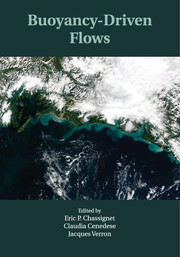Book contents
- Frontmatter
- Contents
- List of Contributors
- Introduction
- 1 Gravity currents – theory and laboratory experiments
- 2 Theory of oceanic buoyancy-driven flows
- 3 Buoyancy-forced circulation and downwelling in marginal seas
- 4 Buoyant coastal currents
- 5 Overflows and convectively driven flows
- 6 An ocean climate modeling perspective on buoyancy-driven flows
- 7 Buoyancy-driven currents in eddying ocean models
- 8 Atmospheric buoyancy-driven flows
- 9 Volcanic flows
- 10 Gravity flow on steep slope
- Index
- Plate section
- References
9 - Volcanic flows
Published online by Cambridge University Press: 05 April 2012
- Frontmatter
- Contents
- List of Contributors
- Introduction
- 1 Gravity currents – theory and laboratory experiments
- 2 Theory of oceanic buoyancy-driven flows
- 3 Buoyancy-forced circulation and downwelling in marginal seas
- 4 Buoyant coastal currents
- 5 Overflows and convectively driven flows
- 6 An ocean climate modeling perspective on buoyancy-driven flows
- 7 Buoyancy-driven currents in eddying ocean models
- 8 Atmospheric buoyancy-driven flows
- 9 Volcanic flows
- 10 Gravity flow on steep slope
- Index
- Plate section
- References
Summary
Introduction
Volcanic systems are controlled by a wide range of fluid mechanical processes, including the subsurface migration and ensuing accumulation of molten rock in crustal reservoirs, know as magma chambers, and the subsequent explosive eruption of ash and transport high into the atmosphere (Sparks et al. 1997). The philosophy of this chapter is to develop a series of simplified physical models of the flow processes in order to gain insights about the dominant controls on the processes; many of the models have been developed based on geological field evidence and have been tested with laboratory experiments. The aim is to build understanding rather than to simulate the processes, which are extremely complex and often for which there is insufficient data for a complete characterization of the physical and chemical state of the system. We provide a brief introduction to the overall range of processes which occur, and then immerse ourselves in some of the fascinating buoyancy-driven flow processes. For a geological introduction to some of the processes and context, textbooks such as McBirney (1985) include a comprehensive description of many of the geological observations and processes.
In magma reservoirs, which may lie 5–10 km below the surface, magma is exposed to the relatively cold surrounding crust, and this may lead to cooling and crystallization of the magma, as well as melting of the surrounding crustal rock, often called country rock. In addition, new magma may be supplied to the magma reservoir leading to pressurization of the system.
- Type
- Chapter
- Information
- Buoyancy-Driven Flows , pp. 338 - 371Publisher: Cambridge University PressPrint publication year: 2012



